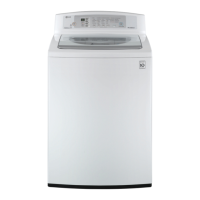14
INSTALLATION INSTRUCTIONS
Connecting the water lines
1
Check the rubber seals on both sides of the hose.
- Insert a rubber seal into the threaded fittings on each
hose to prevent leaking.
Rubber seal
Water hose
(To water inlet on the
washing machine)
Rubber seal
Water hose
(To tap)
WARNING
Do not reuse old hoses.
ü
Only use new hoses when
you install the washing machine. Old hoses could leak
or burst causing flooding and property damage.
2
Connect the water supply hoses to the HOT and COLD
water faucets tightly by hand and then tighten another
2/3 turn with pliers.
- Connect the blue hose to a cold water faucet and the
red hose to a hot water faucet.
WARNING
Do not overtighten.
ü
Damage to the coupling can result.
3
After connecting inlet hose to water faucets, turn on the
water faucets to flush out foreign substances (dirt, sand
or sawdust) in the water lines. Let water drain into a
bucket, and check the water temperature.
4
Connect the hoses to the water inlets tightly by hand and
then tighten another 2/3 turn with pliers.
- Connect the blue hose to the cold water inlet and the
red hose to the hot water inlet.
Cold water inlet
Hot water inlet
WARNING
Do not overtighten the hoses.
ü
Overtightening can
damage the valves resulting in leaking and property
damage.
5
Check for leaks by turning on the faucets.
- If water leaks, check steps 1 to 4 again.
NOTE
Periodically check the hoses for cracks, leaks and wear,
ü
and replace the hoses every 5 years.
When moving or installing the machine do not stretch,
ü
crush of kink the hoses.
Water supply pressure must be between 14.5 PSI and
ü
116 PSI (100~800 kPa). If the water supply pressure is
more than 116 PSI, a pressure reducing valve must be
installed.
To provide optimum washing performance the hot
ü
water temperature should be set at 120-135°F (48-57°C)
and the cold at 60°F (15°C).

